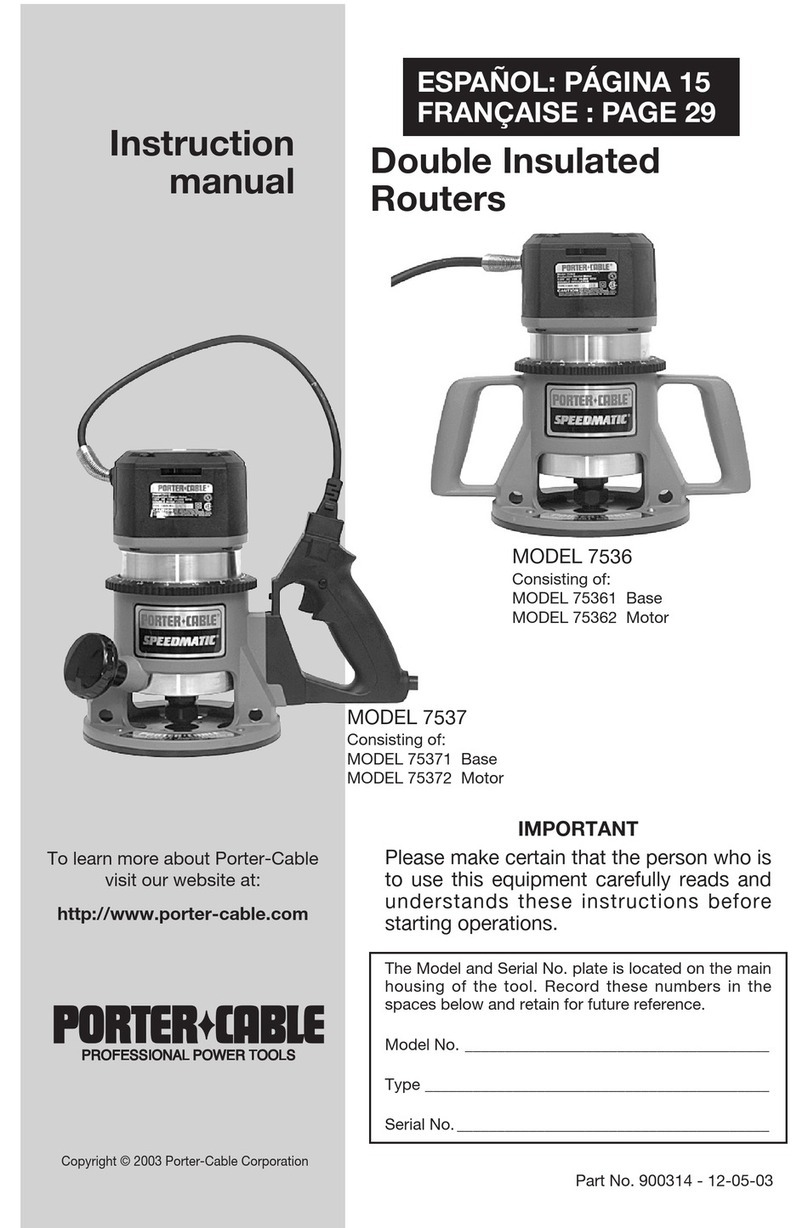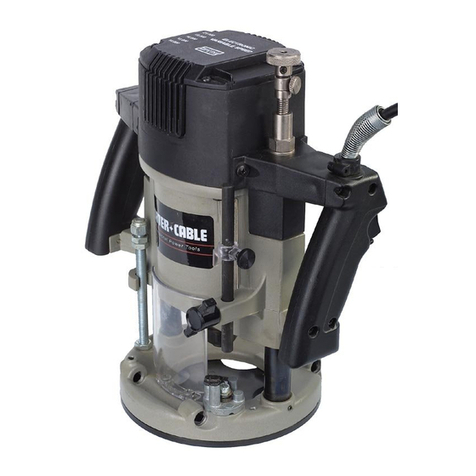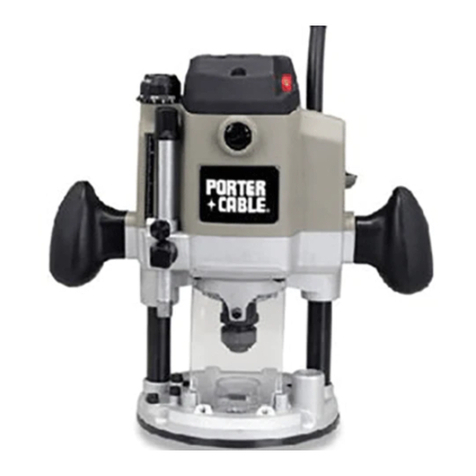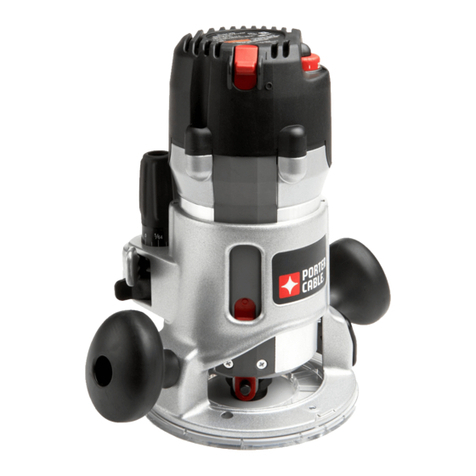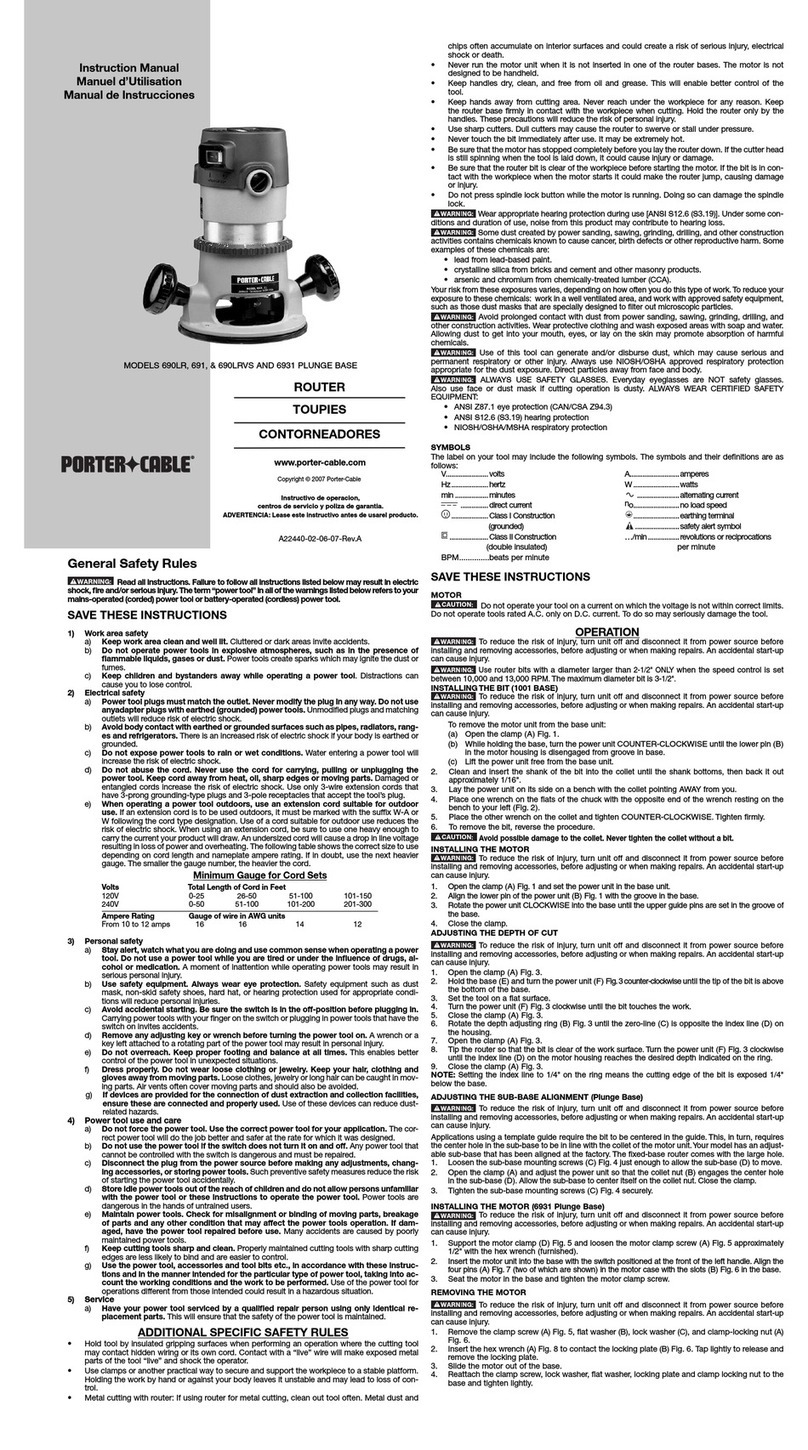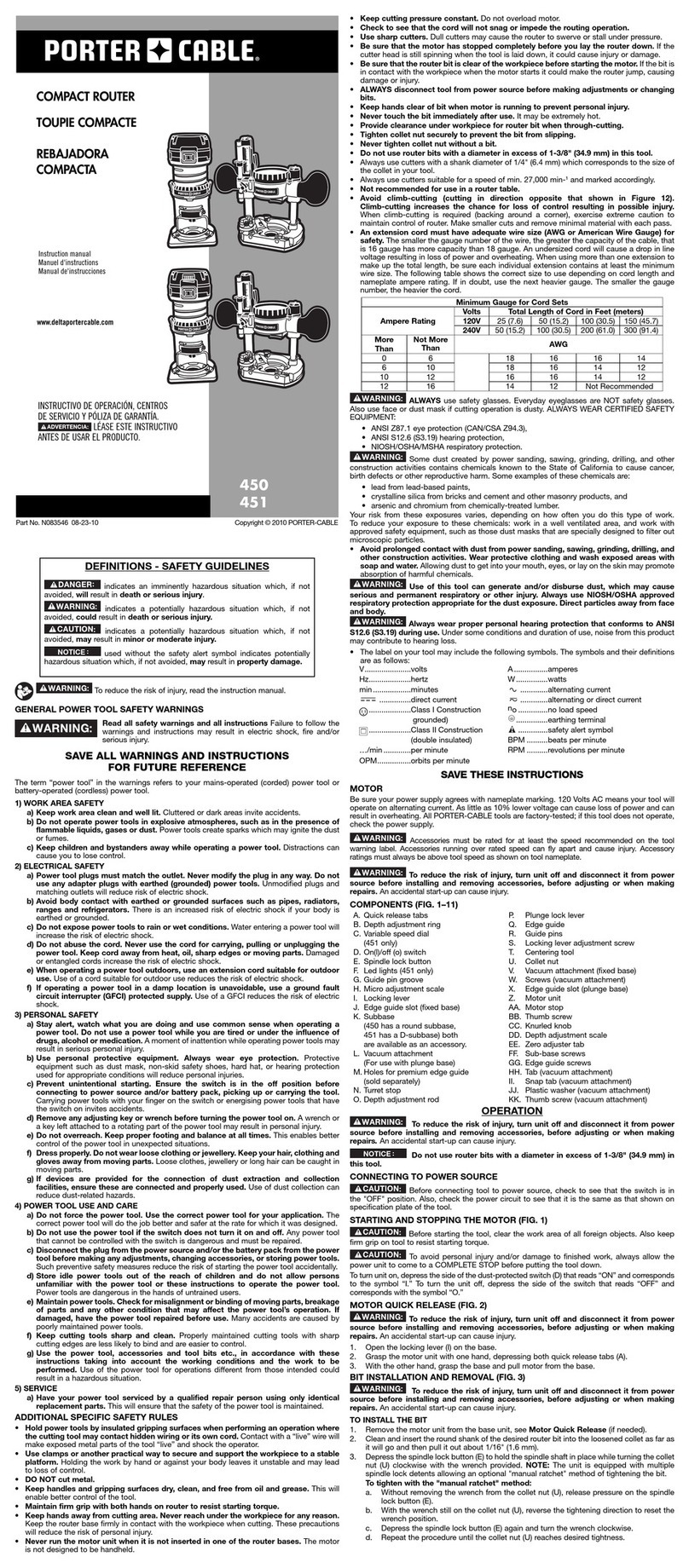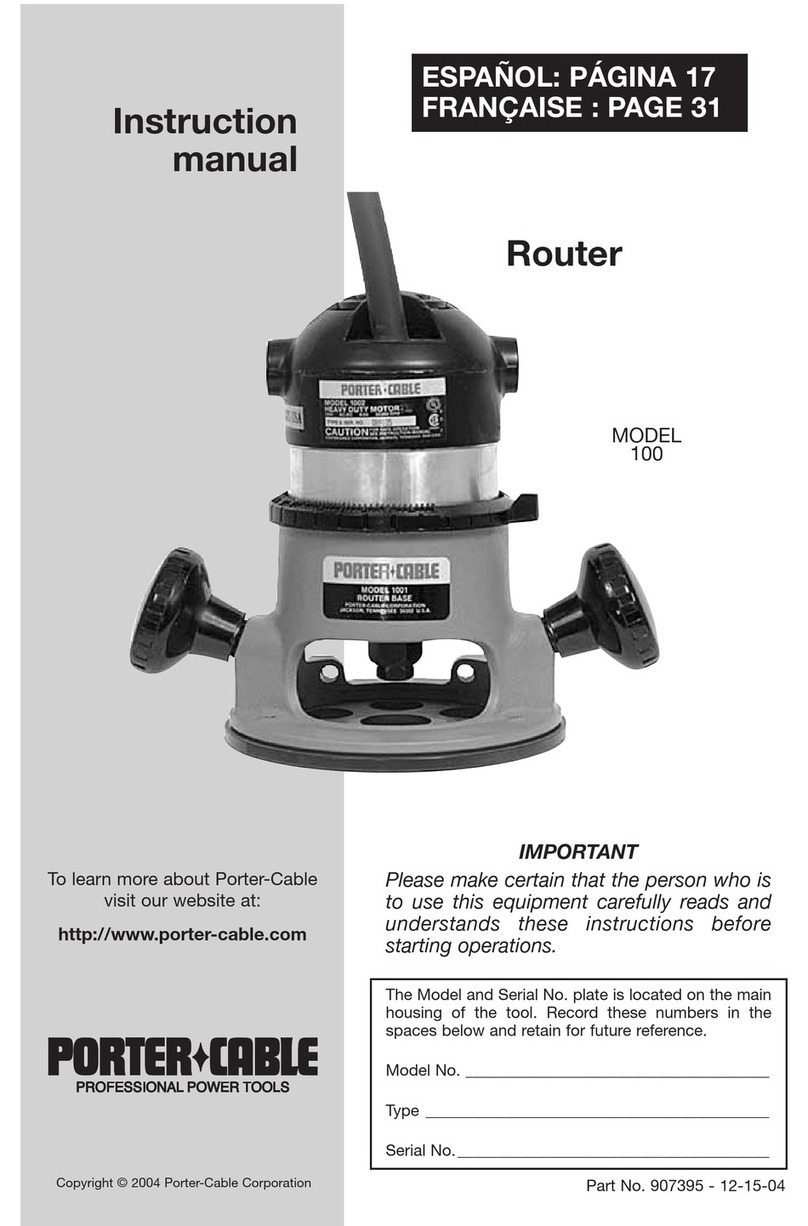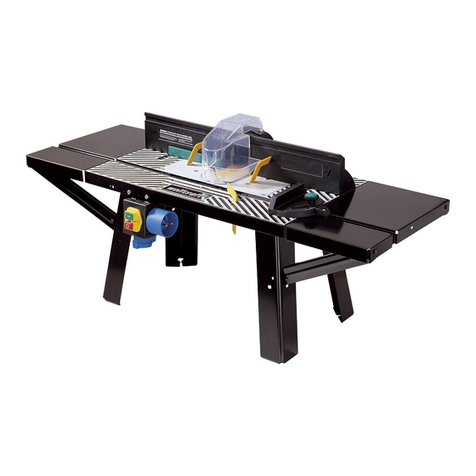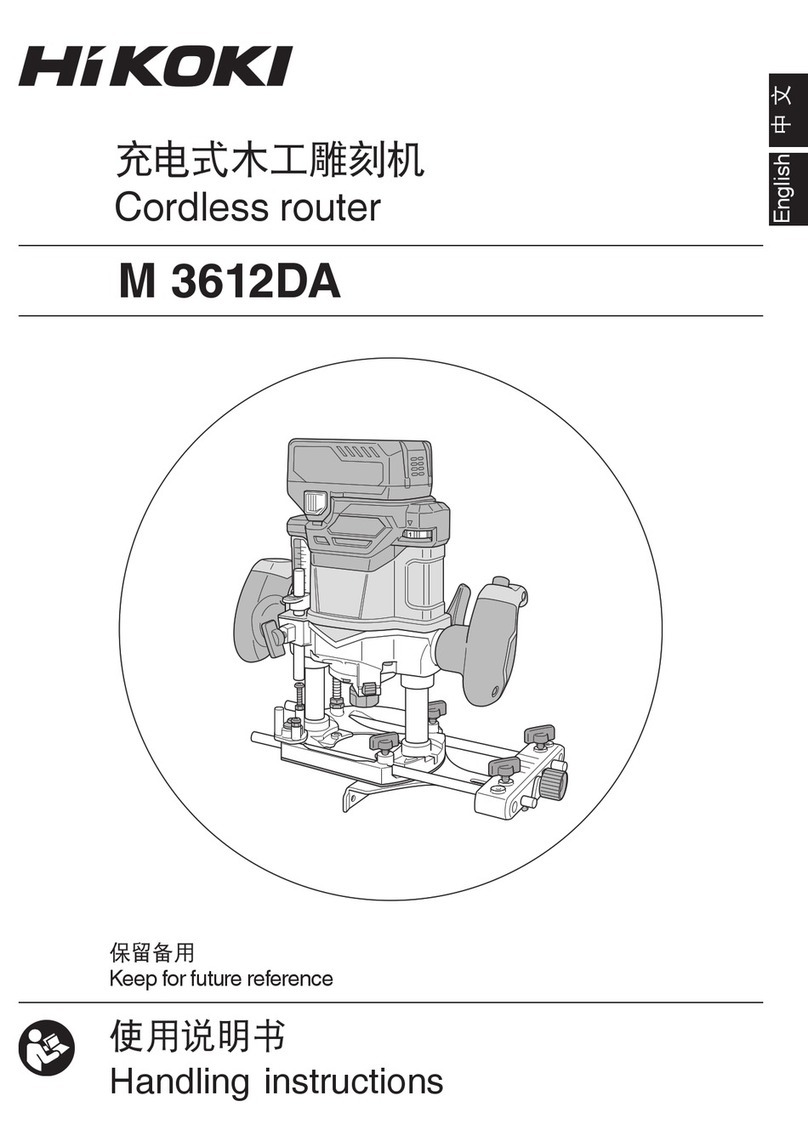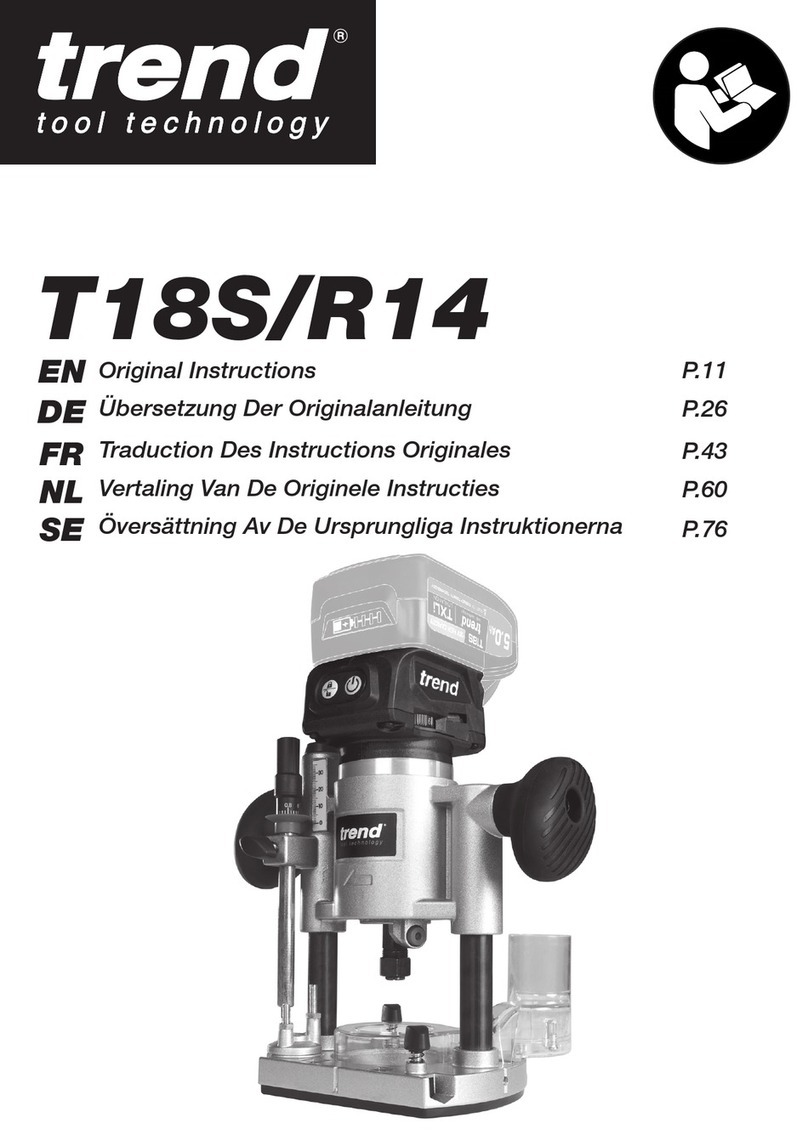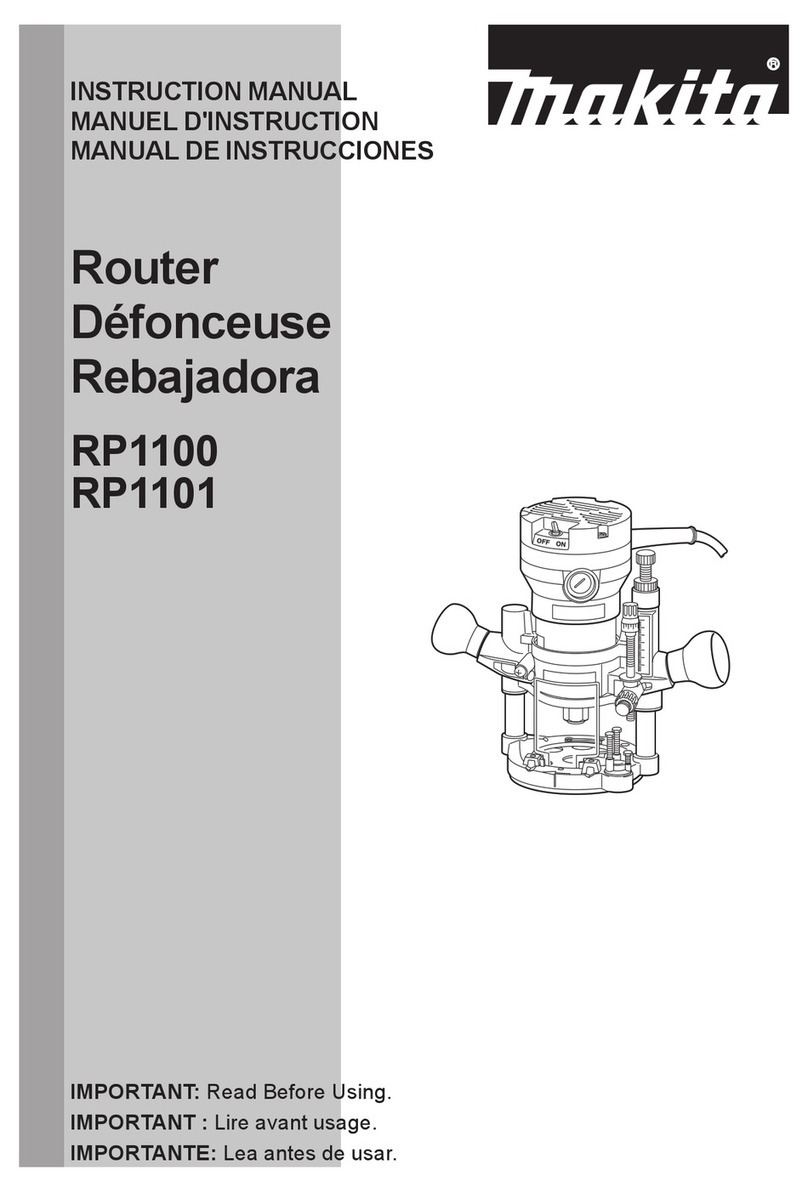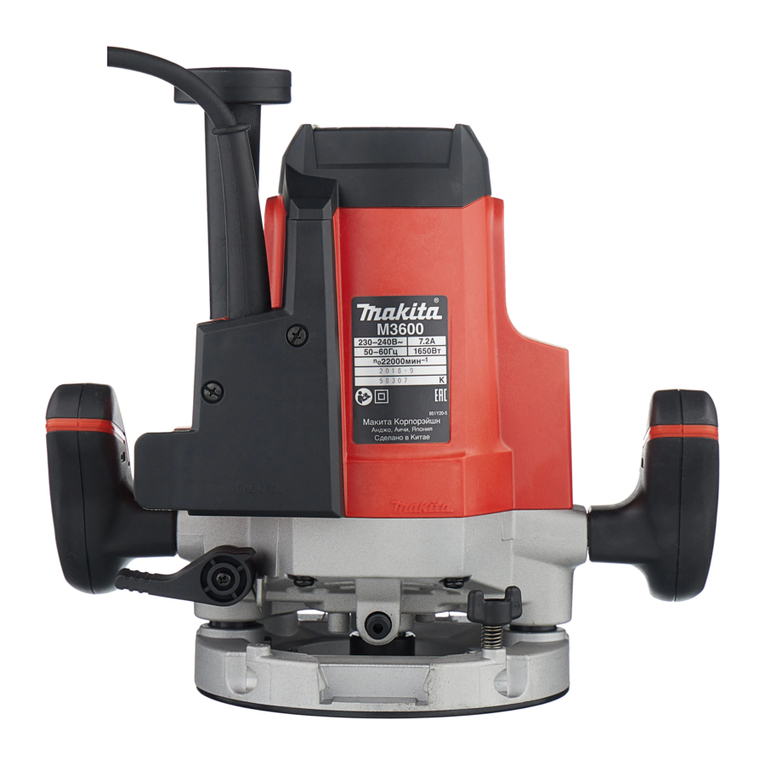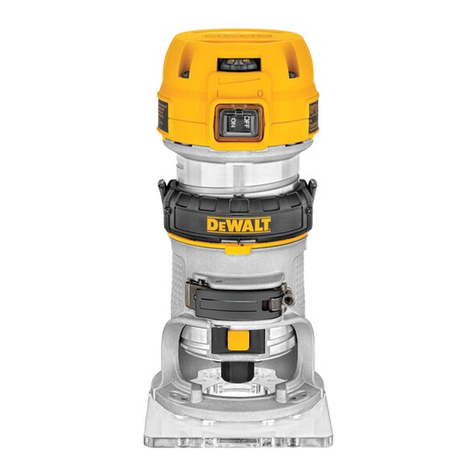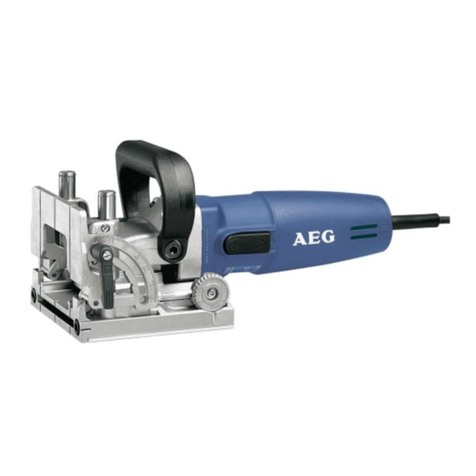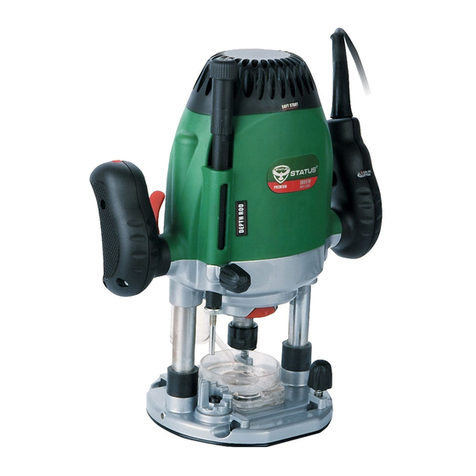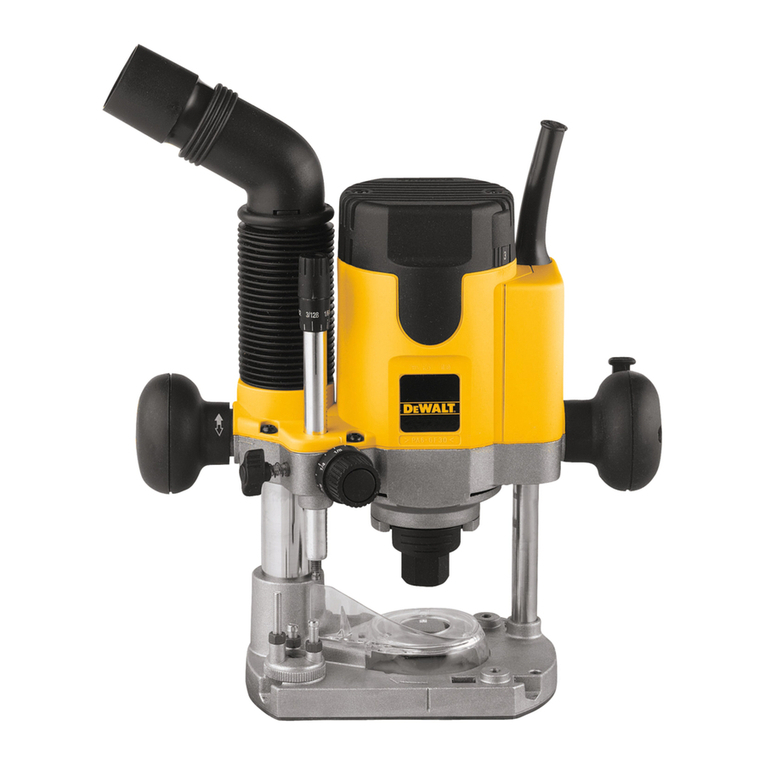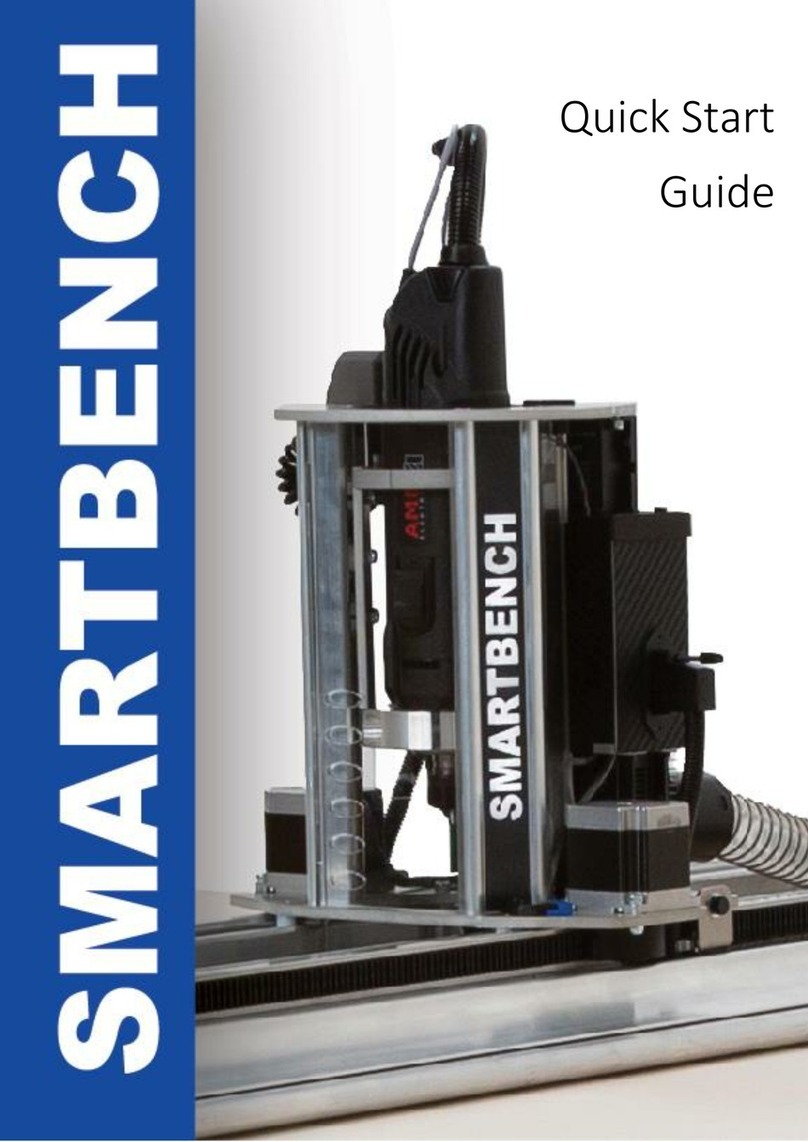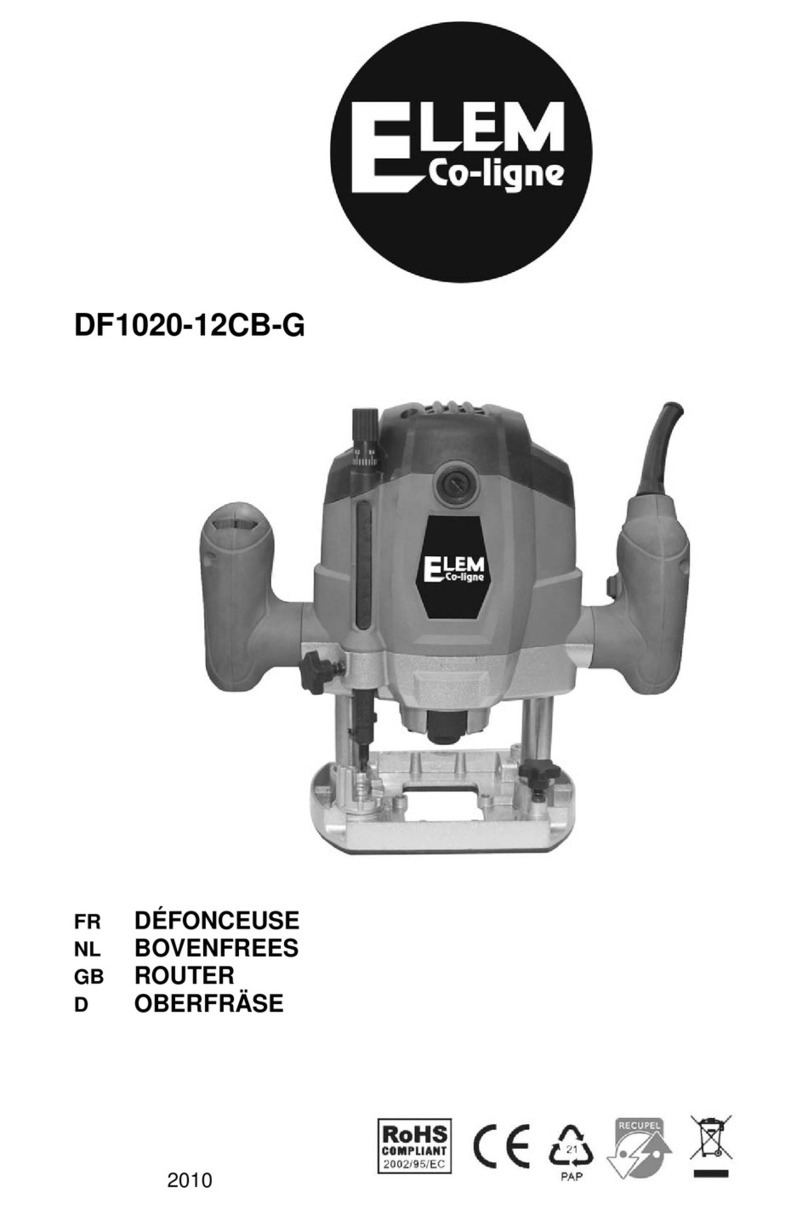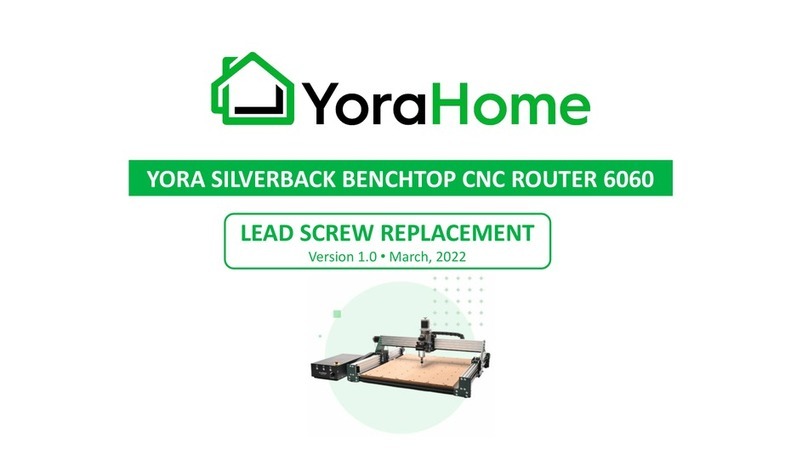
ADJUSTINGTHE SUB-BASE ALIGNMENT (PLUNGE BASE)
Applications using a templet guide require the bit to be centered in the guide.This, in turn, requires
the center hole in the sub-base to be in line with the collet of the motor unit. Your model has an
adjustable sub-base that has been aligned at the factory.The fixed-base router comes with the large
hole. Turn off and unplug the tool before making any adjustments or removing or installing
attachments or accessories. Be sure the switch is in the "OFF" position.
1. Loosen the sub-base mounting screws (B) Fig. 4 just enough to allow the sub-base (C) to
move.
2. Open the clamp and adjust the power unit so that the collet nut (A) engages the center hole in
the sub-base (C). Allow the sub-base to center itself on the collet nut. Close the clamp.
3. Tighten the sub-base mounting screws (B) Fig. 4 securely.
ROUTER
Some dust created by power sanding, sawing, grinding, drilling, and other construction
activities contains chemicals known to cause cancer, birth defects or other reproductive harm.
Some examples of these chemicals are:
• lead from lead-based paints,
• crystalline silica from bricks and cement and other masonry products, and
• arsenic and chromium from chemically-treated lumber (CCA).
Your risk from these exposures varies, depending on how often you do this type of work. To reduce
your exposure to these chemicals: work in a well ventilated area, and work with approved safety
equipment, such as those dust masks that are specially designed to filter out microscopic particles.
• Avoid prolonged contact with dust from power sanding, sawing, grinding, drilling, and other
construction activities. Wear protective clothing and wash exposed areas with soap and water.
Allowing dust to get into your mouth, eyes, or lay on the skin may promote absorption of harmful
chemicals. Use of this tool can generate and/or disburse dust, which may cause serious and
permanent respiratory or other injury. Always use NIOSH/OSHA approved respiratory protection
appropriate for the dust exposure.Direct particles away from face and body.
Wear appropriate hearing protection during use. Under some conditions and duration
of use, noise from this product may contribute to hearing loss.The label on your tool may include the
following symbols.
Do not operate your tool on a current on which the voltage is not within correct limits. Do
not operate tools rated A.C.only on D.C.current.To do so may seriously damage the tool.
Turn off and unplug the tool before making any adjustments or removing or installing
attachments or accessories.Be sure the switch is in the "OFF" position.
Use
router bits with a diameter larger than
2-1/2" ONLY
when the speed control is set
between 10,000 and 13,000 RP
M.
The maximum diameter bit is 3
-1/2".
Disconnect tool from power source when preparing
the router for use, making adjustments,
and when router is not in use.
INSTALLINGTHE BIT (891 AND 892)
1. To remove the motor unit from the base unit:
(a) Open the clamp (A) Fig. 1.
(b) Push the lever (B) Fig. 1 toward the power unit.
(c) Lift the power unit free from the base unit.
2. Clean and insert the shank of the bit into the collet until the shank bottoms, then back it out
approximately 1/16".
3. Lay the power unit on its side on a bench with the collet pointing AWAY from you.
4. Press the spindle lock button (A) Fig. 2.
5. Place the wrench on the collet and turn CLOCKWISE to tighten. Tighten firmly.
6. To remove the bit, reverse the procedure.
®
Read all instructions. Failure to follow all instructions listed below may result in electric
shock, fire and/or serious injury. The term “power tool” in all of the warnings listed below refers to your
mains-operated (corded) power tool or battery-operated (cordless) power tool.
To reduce the risk of injury, user must read instruction manual.
GENERAL SAFETY RULES
1) Work area safety
a) Keep work area clean and well lit.Cluttered or dark areas invite accidents.
b) Do not operate power tools in explosive atmospheres, such as in the presence of
flammable liquids, gases or dust. Power tools create sparks which may ignite the dust or
fumes.
c) Keep children and bystanders away while operating a power tool. Distractions can
cause you to lose control.
2) Electrical safety
a) Power tool plugs must match the outlet. Never modify the plug in any way. Do not
use any adapter plugs with earthed (grounded) power tools. Unmodified plugs and
matching outlets will reduce risk of electric shock.
b) Avoid body contact with earthed or grounded surfaces such as pipes, radiators,
ranges, and refrigerators. There is an increased risk of electric shock if your body is
earthed or grounded.
c) Do not expose power tools to rain or wet conditions. Water entering a power tool will
increase the risk of electric shock.
d) Do not abuse the cord. Never use the cord for carrying, pulling or unplugging the
power tool. Keep cord away from heat, oil, sharp edges or moving parts. Damaged
or entangled cords increase the risk of electric shock.Use only 3-wire extension cords that
have 3-prong grounding-type plugs and 3-pole receptacles that accept the tool's plug.
e) When operating a power tool outdoors, use an extension cord suitable for outdoor
use. Use of a cord suitable for outdoor use reduces the risk of electric shock.When using
an extension cord, be sure to use one heavy enough to carry the current your product will
draw. An undersized cord will cause a drop in line voltage resulting in loss of power and
overheating. The following table shows the correct size to use depending on cord length
and nameplate ampere rating. If in doubt, use the next heavier gauge. The smaller the
gauge number, the heavier the cord.
Minimum Gauge for Cord Sets
Volts Total Length of Cord in Feet
120V 0-25 26-50 51-100 101-150
240V 0-50 51-100 101-200 201-300
Ampere Rating
More Not more AWG
Than Than
0 - 6 18 16 16 14
6 - 10 18 16 14 12
10 - 12 16 16 14 12
12 - 16 14 12 Not Recommended
3) Personal safety
a) Stay alert, watch what you are doing and use common sense when operating a power
tool. Do not use a power tool while you are tired or under the influence of drugs, alcohol
or medication. A moment of inattention while operating power tools may result in serious
personal injury.
b) Use safety equipment. Always wear eye protection. Safety equipment such as dust mask,
non-skid safety shoes, hard hat, or hearing protection used for appropriate conditions will
reduce personal injuries.
c) Avoid accidental starting. Ensure the switch is in the off-position before plugging in.
Carrying power tools with your finger on the switch or plugging in power tools that have the
switch on invites accidents.
d) Remove any adjusting key or wrench before turning the power tool on. A wrench or a key
left attached to a rotating part of the power tool may result in personal injury.
e) Do not overreach. Keep proper footing and balance at all times.This enables better control
of the power tool in unexpected situations.
f) Dress properly. Do not wear loose clothing or jewelry. Keep your hair, clothing and gloves
away from moving parts. Loose clothes, jewelry or long hair can be caught in moving parts.
g) If devices are provided for the connection of dust extraction and collection facilities, ensure
these are connected and properly used. Use of these devices can reduce dust-related haz-
ards.Accessories that may be suitable for one tool, may become hazardous when used
on another tool.
4) Power tool use and care
a) Do not force the power tool. Use the correct power tool for your application. The correct
power tool will do the job better and safer at the rate for which it was designed.
b) Do not use the power tool if the switch does not turn it on and off. Any power tool that
cannot be controlled with the switch is dangerous and must be repaired.
c) Disconnect the plug from the power source before making any adjustments, changing
accessories, or storing power tools. Such preventive safety measures reduce the risk of
starting the power tool accidentally.
d) Store idle power tools out of the reach of children and do not allow persons unfamiliar with
the power tool or these instructions to operate the power tool. Power tools are dangerous
in the hands of untrained users.
e) Maintain power tools.Check for misalignment or binding of moving parts, breakage of parts
and any other condition that may affect the power tools operation. If damaged, have the
power tool repaired before use. Many accidents are caused by poorly maintained power
tools.
f) Keep cutting tools sharp and clean. Properly maintained cutting tools with sharp cutting
edges are less likely to bind and are easier to control.
g) Use the power tool, accessories and tool bits etc., in accordance with these instructions
and in the manner intended for the particular type of power tool, taking into account the
working conditions and the work to be performed. Use of the power tool for operations
different from those intended could result in a hazardous situation.
5) Service
a) Have your power tool serviced by a qualified repair person using only identical replacement
parts.This will ensure that the safety of the power tool is maintained.
Instruction Manual
MODELS 891, 892, & 8931 PLUNGE BASE
Avoid possible damage to the collet. Never tighten the collet without a bit.
1. Open the clamp (A) Fig. 1 and set the power unit in the base unit.
2. Align the rack and pin (C) Fig. 1 of the power unit with the grooves in the base. Pull the lever
(B) Fig. 1, and lower the motor into the base.
3. Close the clamp (A).
4. Reverse the procedure to remove.
INSTALLING THE MOTOR
ADJUSTINGTHE DEPTH OF CUT
1. Open the clamp (A) Fig. 3.
2. Pull the lever (B) and set the router on the workpiece.With the router flat and level, let the bit barely
touch the workpiece.
3. Hold the lever (B) and turn the depth knob (C) until the zero aligns with the zero mark on the router
base.
4. Release the lever (B).Make sure that the zero remains aligned with the zero mark.
5. Turn the knob (C) clockwise to the desired depth of cut.
6. Close the clamp (A).
NOTE: Setting the index line to 1/16" on the knob indicates that the cutting edge of the bit is exposed
1/16" below the base.
VACUUM HOSE
You can attach a standard 1" vacuum hose (A) Fig.5 to the dust port (B) Fig. 5 to connect the tool to
a vacuum cleaner or dust collection system.
1. HOLD POWER TOOLS BY INSULATED GRIPPING SURFACES when performing an
operation where the cutting tool may contact hidden wiring or its own cord. Contact with a "live"
wire will make exposed metal parts of the tool"live" and shock the operator.
2. USE CLAMPS or other practical way to secure and support the workpiece to a stable platform.
Holding the work by hand or against your body is unstable and may lead to loss of control.
3. DISCONNECT TOOL FROM POWER SOURCE before making adjustments or changing bits.
4. TIGHTEN COLLET NUT securely to prevent the bit from slipping.
5. USE A CLAMP or some other device to hold the workpiece rigidly in position and clear the path of
the tool of obstructions.
6. PROVIDE CLEARANCE under workpiece for router bit when through-cutting.
7. CHECK TO SEE THAT THE CORD will not “hang up” during routing operation.
8. CLEAR THE ROUTER BIT AREA before starting motor.
9. MAINTAIN FIRM GRIP on router to resist starting torque.
10. KEEP HANDS CLEAR OF BIT when motor is running to prevent personal injury.
11. KEEP CUTTING PRESSURE CONSTANT. Do not overload motor.
12. LET THE MOTOR COME TO A COMPLETE STOP before putting the tool down.
13. NEVER TOUCH router bits after use.They may be extremely hot.
14. NEVER TIGHTEN COLLET NUT without a bit.
15. DO NOT USE ROUTER BITS with a diameter in excess of 2-1/2" at RPM above 13,000.Router
bits up to 3-1/2" in diameter can be used when speed control is set for 13,000 RPM or less.
16. ALWAYS KEEP CHIP SHIELD clean and in place.
17. AVOID “CLIMB-CUTTING” (see “Using The Router” section in this manual). “Climb-cutting”
increases the chance for loss of control resulting in possible personal injury.
18. DO NOT HAND-HOLDTHE ROUTER IN AN UPSIDE-DOWN OR HORIZONTAL POSITION.The
motor can separate from the base if not properly attached according to the instructions.
SYMBOLS
The label on your tool may include the following symbols:
V ...........volts A ...................amps
Hz.........hertz W ..................watts
min .......minutes or a.c. ..alternating current
.. direct current no..................no load speed
.......class II tool ...........protective earth
./min .....revolutions per minute
INSTALLING AND REMOVING THE BIT (8931 PLUNGE BASE)
If you remove the springs from the posts (E) Fig. 7 to use the plunge base in a router
table, remove the post plugs carefully. They are spring-loaded and should be removed only when the
base housing is in the "up" position (Fig. 6).
ADJUSTINGTHE PLUNGE BASE
1. Loosen the depth rod locking knob (A) Fig. 7, and depth indicator knob (C) Fig. 7, allowing the
depth rod (D) Fig. 7 to contact one of the turret stops (A) Fig. 8. Normally the deepest desired
cut is set with the depth rod resting on the base casting (B) Fig. 7.You can adjust the other three
adjustable stops (A) Fig. 8 to any desired height.You can also utilize any combination of fixed
and/or adjustable stops to achieve the desired depths required for a particular job.The adjustable
stop (B) Fig. 8 will raise or lower that stop by 1/32" with one full turn of the stop.
2. Release the plunge mechanism by pulling the locking lever (A) Fig. 10 down. Lower the plunge
mechanism until the router bit touches the work surface. Release the lever and push it to the
right to lock the mechanism in this position.
3. Tighten the depth-rod locking knob (A) Fig. 7.
4. Position the depth indicator (C) Fig. 9 at the “0” position and tighten the knob (C) Fig. 7.
5. Loosen the depth-rod locking knob (A) Fig 7, and raise until the indicator aligns with the
graduation representing the desired depth of plunge (Fig. 9).
To remove the motor unit from the base:
1. Pull the lever (C) Fig. 5 toward you.
2. Remove the power unit from the base.
3. Clean and insert the shank of the bit into the collet until the shank bottoms, then back it out
approximately 1/16".
4. Lay the power unit on its side on a bench with the collet pointing AWAY from you.
5. Press the spindle lock button (A) Fig. 2.
6. Place the wrench on the collet and turn CLOCKWISE to tighten. Tighten firmly.
7. To remove the bit, reverse the procedure.
SAVE THESE INSTRUCTIONS!
ADDITIONAL SPECIFIC SAFETY RULES
